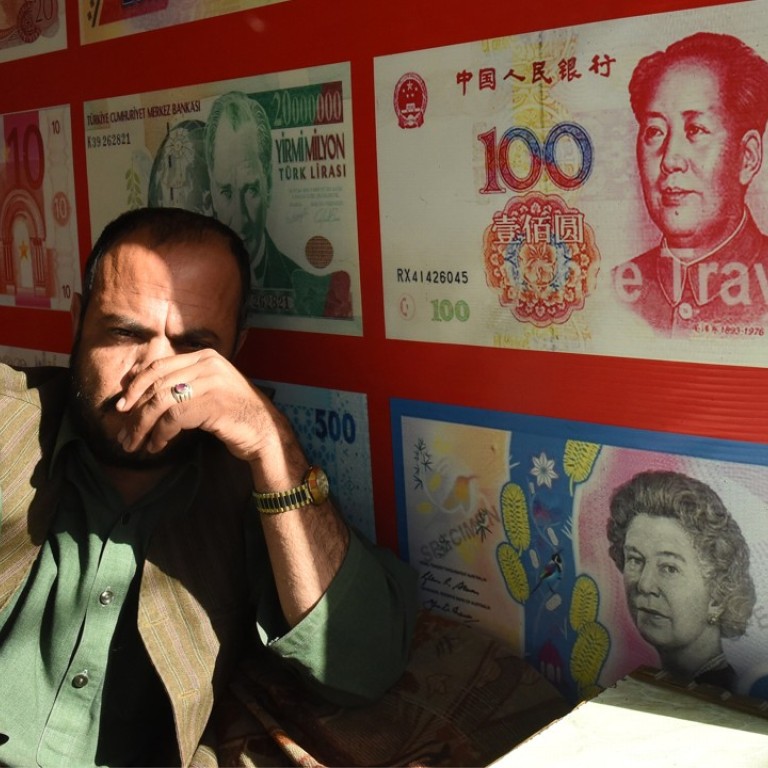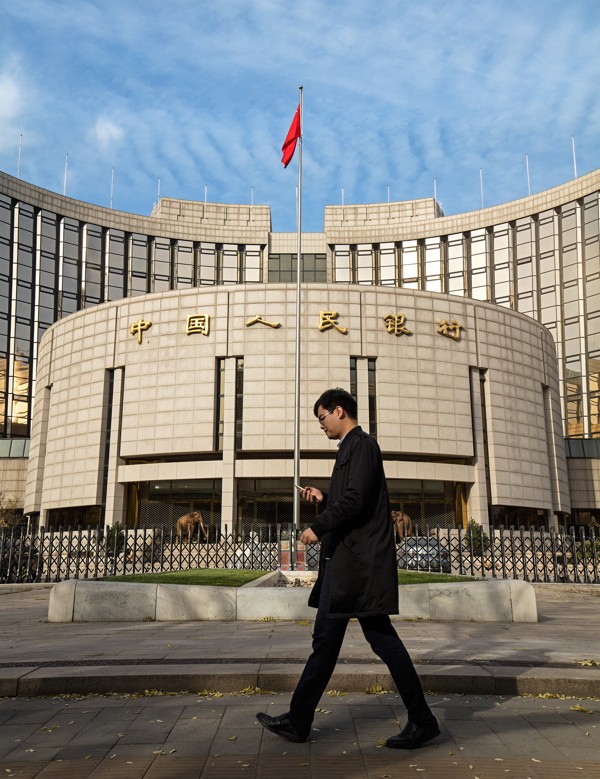
US-China trade war is helping to boost use of yuan in international transactions
Overseas holdings of Chinese currency by institutions, individuals and central banks is on the rise
The trade war initiated by the United States is actually helping China achieve one of its coveted long-term financial goals – the greater use of its currency, the yuan, in international commerce and financial transactions.
As of the end of the second quarter, overseas institutional and individual holdings of yuan-denominated financial assets totalled 4.9 trillion yuan (US$717 billion), according to ICBC International, the Hong Kong investment banking arm of Industrial and Commercial Bank of China, one the country’s big four banks. Within that total, the share of yuan-denominated stocks and bonds as a percentage of total assets held by global investors increased to about 2.5 per cent and 3.0 per cent, respectively.
China’s yuan sinks, but neither its central bank nor investors are showing signs of panic
In addition, the holdings of yuan assets by global central banks increased for a third straight quarter to 1.39 per cent in the first quarter this year, edging up from 1.22 per cent at the end of 2017 and 1.08 per cent at the end of 2016, when the International Monetary Fund began reporting central banks’ yuan allocations after the Chinese currency was included in its Special Drawing Rights currency basket in November 2015.
The unintended consequence of the US fighting across multiple fronts drills home the point that the world needs an alternative to the US dollar for trade and transfers
The yuan has a long way to go to match, let alone replace, the US dollar as the world’s favourite transaction currency. But the pressures brought on China and some of its trading partners by US sanctions have caused some to rethink their reliance on the greenback.
Despite the trade war and the sharp depreciation of the yuan against the dollar this year, there are signs the use of the yuan on a global basis is starting to pick again.
The irony is not lost on Kay Van Petersen, global macro strategist at Saxo Capital Markets based in Singapore.
“The unintended consequence of the US fighting across multiple fronts drills home the point that the world needs an alternative to the US dollar for trade and transfers,” he said. “If anything, the trade war will lead to a redoubling of efforts on the structural roll out of the yuan to echo this internationalisation theme.”
As a payment currency for merchandise trade, the yuan kept its position as the fifth most active currency by value in July, at 2.04 per cent of all transactions, according to data from global payments messaging system SWIFT. Overall, the value of yuan payments increased by 9.91 per cent compared with June 2018. The share of the top ranked US dollar was at 38.99 per cent of all transactions while the euro, in second place, was at 34.71 per cent.
Internationalising the yuan
The confrontational foreign policy approach of US President Donald Trump, against China, Russia, Iran and other countries, may be fortifying Beijing’s ambitions to internationalise its currency and to build its status as a global superpower, analysts said.
Overreliance on the US dollar for the settlement of trade transactions is risky for China during times of uncertainty, such as now, since a stronger dollar raises the price China must pay for the dollar-denominated commodity imports on which it relies. The result is lower Chinese purchasing power and higher costs for food and energy imports, and higher yuan bills for interest payments on dollar-denominated debt, they said.
Global institutional and government investors may be taking the hint that a protracted trade war could bring a sea change to China’s financial markets, as shown by the increase so far this year in their holdings in yuan-denominated stocks and bonds.
China has struggled recently to increase the global acceptance of the yuan beyond its initial use as a settlement currency. The use of the yuan outside mainland China for trade and transactions took off for a period after the global financial crisis in 2008, but has dwindled since 2016 because of depreciation pressures and the implementation of strict government controls to prevent capital outflows.
Why the yuan won’t follow the Turkish lira into free fall
China’s decision to launch the initiative linking the Hong Kong stock market with the Shanghai exchange in 2014 and the Shenzhen exchange in 2016, and the Bond Connect scheme last year, allowing foreigners to invest in mainland Chinese capital markets, has increased investment flows into its economy. Increasing foreign purchases of Chinese stocks and bonds will help the government broaden the yuan’s use for investment purposes on top of trade payments.
The Chinese authorities also launched yuan-denominated gold contracts on the Hong Kong and Dubai exchanges last year, as well as new “Petroyuan” oil futures contracts on the Shanghai International Energy Exchange (INE) in March this year.
China, the world’s largest oil importer, wants to compete with US dollar-denominated Brent and West Texas Intermediate (WTI) contracts, which have been the industry standards for decades.

“We now think these oil [producing] countries who are selling oil into these contracts and are getting paid in yuans are starting to recycle their profits back into Chinese government bonds, and this is going to continue for decades,” said Hayden Briscoe, head of Asia-Pacific fixed income at UBS Asset Management.
“Shanghai crude futures contracts have already captured 15 per cent of the world’s turnover. It’s an opportunity to get countries to embrace for immunity.”
In the 1970s, the US brokered a deal where it would buy oil from Saudi Arabia and provide the kingdom with military aid and equipment. In return, the Saudis would plough billions of their petrodollar revenue back into US treasuries and finance America’s spending. Saudi held US$164.9 billion in US government debt as of the end of June this year.
China has slapped tariffs on US$50 billion worth of US goods in its tit-for-tat trade war with the US, but has so far avoided tariffs on oil. But some Chinese importers are starting to switch out of US dollar-denominated crude contracts. International media reported Dongming Petrochemical Group, an independent refiner based in Shandong province, recently cancelled its US crude orders and plans to switch to Middle East or West African supplies, which could potentially be valued in yuan.
Countries such as Iran will welcome the ability to circumvent US sanctions by exporting goods to China that can be settled in yuan, said John Tan Ming-kiu, regional head of financial markets at Standard Chartered Bank. China has said it will not comply with US sanctions on Iran and will continue to import its oil.
Five companies, including state-owned Unipec and Zhenhua Oil, are this month delivering a combined 600,000 barrels of Middle Eastern crude to buyers of the INE, the first physical settlement of a yuan-denominated contract, according to Reuters. Sources said Iran is still assessing the potential impact of US sanctions and has not yet signed any yuan-denominated crude delivery contracts.
“China is working on its relationships with the dominant oil and resource exporters to get them to settle in yuan,” said Tan.
Continued delinking from US dollar

Over the past decade, the yuan has been treated as an important policy tool and kept on a tight leash by the People’s Bank of China.
China’s yuan exchange rate regime has moved from being a hard peg to the dollar for a two-year period after the outbreak of the financial crisis in 2008, and then towards a crawling peg from mid-2010 onwards as the yuan’s link to the dollar gradually loosened. Since August 2015, the PBOC has used a managed peg for the yuan, for greater two-way flexibility in its movements against the dollar, analysts said.
The fact that foreign ownership of Chinese assets increased even as Chinese authorities allowed the yuan to weaken against the strengthening dollar suggests the yuan’s use is continuing to delink from the US dollar, said Jack Wang, an analyst at ICBC International.
In August, the yuan dropped by 0.2 per cent to trade at 6.8299 against the US dollar. That marked its fifth straight month of decline, its longest losing streak since 1993. Other Asian and frontier currencies have dropped more sharply during the month, including Indonesia’s rupiah, India’s rupee, Argentina’s peso and Turkey’s lira, as the US dollar strengthened amid rising global trade tensions.
“The global status of the yuan is increasingly becoming less reliant on its swings against the dollar. This is part of the process on the road to the internationalisation of the yuan, ” said Wang.
Standard Chartered’s Tan, however, said China has installed a number of “control points” for the yuan-dollar exchange rate aimed at preventing a sharp rise in capital outflows or panic selling by traders and investors.
In the unlikely circumstance that China and the US miscalculate and trade tensions morph into risks of military confrontation over Taiwan or the South China Sea, this could result in a vicious cycle of self-fulfilling yuan depreciation expectations, which would be a major blow to China’s economy. In such a scenario, the PBOC could take firm control of the yuan and its internationalisation would come to an abrupt halt, said Tan.
For the expansion of the yuan’s use to reach significantly higher levels, companies will have to choose to re-denominate their balance sheets in yuan and diversify away from US Treasuries for short-term liquidity management, Hong Kong Exchanges and Clearing chief executive Charles Li Xiaojia said in June. People would use the yuan not as a way to speculate but for newly acquired attributes such as its liquidity outside China, its ease of use and its safety, said Li.
Winners and losers as yuan weakens against the dollar and trade war fears become reality
“People need to have no feelings for yuan appreciation or depreciation. They just need it to manage their treasury operations,” Li added. “Until you get to that point, the yuan is only going to be a settlement currency, at best a currency for investment.”
Even the recent increase in the use of the yuan is directly tied to trade with China. For the yuan to be a true global settlement currency, third parties will have to use it in their transactions. Now, the US dollar dominates those transactions and that is unlikely to change dramatically any time soon.
Additional reporting by Daniel Ren in Shanghai

